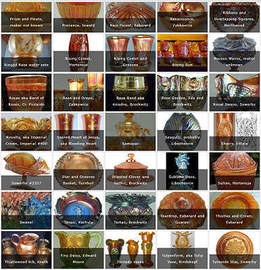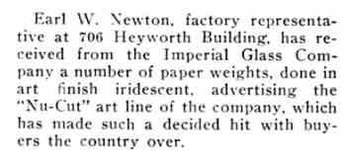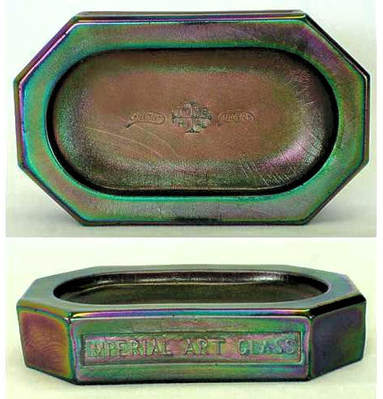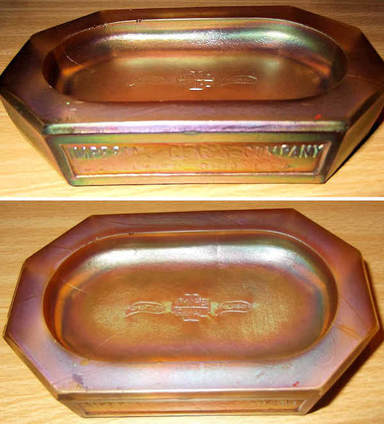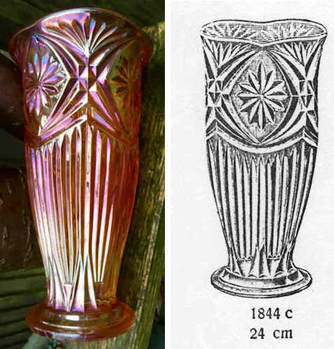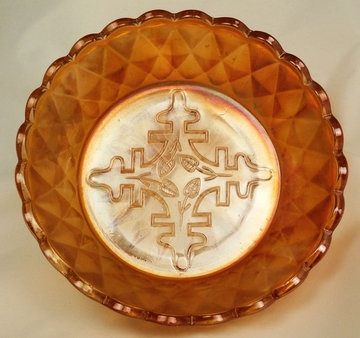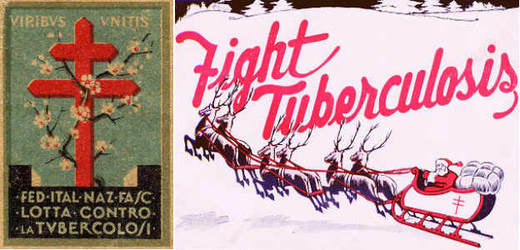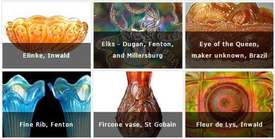NetworK ezine Issue 33. February 2018
Totally devoted to Carnival Glass
|
Collectors Facts Edition
Over many years of collecting and researching Carnival Glass, we have assembled a unique feature on our website - Carnival Glass Worldwide Collectors Facts. It's a "go to" place to look for those hard-to-identify patterns, or to find out fascinating facts, revelations and even some Carnival trivia! There are now over 160 patterns featured in this hugely popular section of our website - from Amazon Women to Witny, with Elks, Kookaburras and the Peoples Vase along the way. Something for all Carnival Collectors to enjoy! In this February Edition of NetworK, we cover three of the latest additions to our Collectors Facts - each one has a separate link to their Collectors Facts page, if you want to read more about them. At the end of this ezine we'll repeat the link to the Collectors Facts Homepage (or click on the screenshot on the right). |
|
Imperial Paperweight in the News
Browsing the “Pottery, Glass and Brass Salesman” journal, from February 1917, this news item caught our eye. There’s only one piece this could have been!
Yes, it’s the magnificent, iridescent Imperial Paperweight that has Nuart and Nucut either side the Imperial Iron Cross mark. (Picture of this purple one on the right is courtesy of Seeck Auctions). But stop! Take a look at the date of the news item – February 1917. This date completely over-turns all previous thinking regarding the date of production, which has formerly been quoted as 1921 or even as late as 1924. In fact the Imperial Paperweight was produced many years earlier, in early 1917. |
|
Why was it previously believed to be later? Simple. The Paperweight also has Imperial's Iron Cross mark moulded on its top - previously it has been thought that the trademark was not in use until 1921.
In fact, although the trademark was certainly registered in 1921, it was in use several years before that date. Here’s the evidence to prove its earlier usage, as seen in August 1914 “Pottery, Glass & Brass Salesman”. And here's another interesting revelation - up until November 2017, it was considered that the Imperial Paperweight was only ever made in purple … then Don Leininger showed us this amazing marigold one in an Imperial Facebook Group post. He’s kindly given us permission to share this superb discovery with you all here – thank you Don.
You can read the true story behind this fascinating item on our website. Who exactly was Earl W. Newton (the man mentioned in the news clip above)? Was it originally intended as a paperweight, or were other uses in mind? Read it here - Collectors Facts: Imperial Paperweight. |
|
Meet Linz There’s a huge amount of pleasure and satisfaction in finding a pattern that hasn’t been seen before. But that pleasure is so much greater when the piece can actually be attributed to a maker. The mystery is solved, and the first known piece not only has a name, but crucially, a maker and a country of origin. So, may we introduce you to “Linz” – a magnificent new discovery that was made by Lynne Martin. This beauty is the first vase known in this pattern, and we can confirm that it was made by Rindskopf in Czechoslovakia (circa 1920s). Picture courtesy of Lynne Martin. Lynne explains that the vase stands 9 inches high and has excellent iridescence, as the photo shows. You can see more of Lynne’s lovely photos of this fascinating Rindskopf vase in our Collectors Facts series on “Linz”. Sincere thanks to Lynne for letting us share this brilliant discovery with all our readers. Read about it here - Collectors Facts: Linz vase |
Linz vase (picture courtesy of Lynne Martin) with
an extract from Rindskopf's catalogue, circa 1920s. |
Oxford Cross
|
So, what is this enigmatic piece in question?
Step forward “Oxford Cross”, a 6¼ inch wide marigold bowl that we named some twenty years ago when we found it in an antique mall in Oxford – the university city famed for its “dreaming spires”. We named the exterior pattern "Oxford Diamonds". The distinctive design on its wide and flat interior captivated and intrigued us. We’ve puzzled for years what the design on its interior might represent, but nothing made sense … until a few weeks ago, while we were browsing newspapers from 1937. |
Is this a rare and mystical piece of Carnival Glass bearing emblems and symbols, created for the illuminati …
... or is it a commercial item featuring a promotional logo as a fund raiser? |
We came across an ad that stopped us in our tracks because the cross (below) shown in the ad was almost identical to the repeated motif on our mystery bowl. Underneath the cross were the words “HELP TO FIGHT TUBERCULOSIS”.
|
Our theory is that the marigold Carnival bowl was a commercially produced, promotional item, featuring the symbol /logo of the international Campaign against TB – and its sales were used to raise funds for that campaign. There is also an amazing link to Harley-Davidson! There's lots more to see and read in our fact-finding article on the Oxford Cross on our website: Collectors Facts: Oxford Cross. |
The Symbol for a Worldwide Campaign From 1902, for over 50 years, one of the biggest international health campaigns ever known, was formed to fight the dreaded disease, tuberculosis. Its symbol, used worldwide for many decades, on all promotional campaign material, was the Cross of Lorraine, as shown left and below. On the left is an Italian graphic illustration and on the right, a USA Christmas poster
in which Santa’s sleigh features the Lorraine Cross, both from the 1930s. |
Another Wonderful Video!
We have just released the third video in the “Howard Seufer Presents” series.
We have just released the third video in the “Howard Seufer Presents” series.
|
In this unique footage, filmed by the late Howard Seufer as part of a longer interview with Frank M. Fenton, you’ll see an array of vases like no other. Listen to Frank describing the production of a swung vase as being “twirled like a baton”! Don’t miss Frank's astonishing revelation of the original cost of the Birmingham Age Herald plates! And for all you vase aficionados, watch out for the peacock tail pattern inside the “as pressed” April Showers vase. Filmed almost fifteen years ago inside the (now long-gone) Fenton Museum. The video runs for about 5 minutes. Click on the image, left, or go here: “Frank Fenton Discusses Vases & Lettered”. The video runs for 6 minutes. The videos are courtesy and Copyright, Marty Seufer, 2017-18. |
|
Here's the link to our Collectors Facts Homepage Follow the link to find over 160 featured Carnival Glass patterns, with new ones being added all the time. Click on the image or go here: Collectors Facts. |
Join us on Facebook
We invite you and your friends to join us all on NetworK's fast growing and very active Facebook Group (link is below), and if you have missed any of the previous issues of NetworK and NetworK Specials, they are all here: Back Issues.
We invite you and your friends to join us all on NetworK's fast growing and very active Facebook Group (link is below), and if you have missed any of the previous issues of NetworK and NetworK Specials, they are all here: Back Issues.

